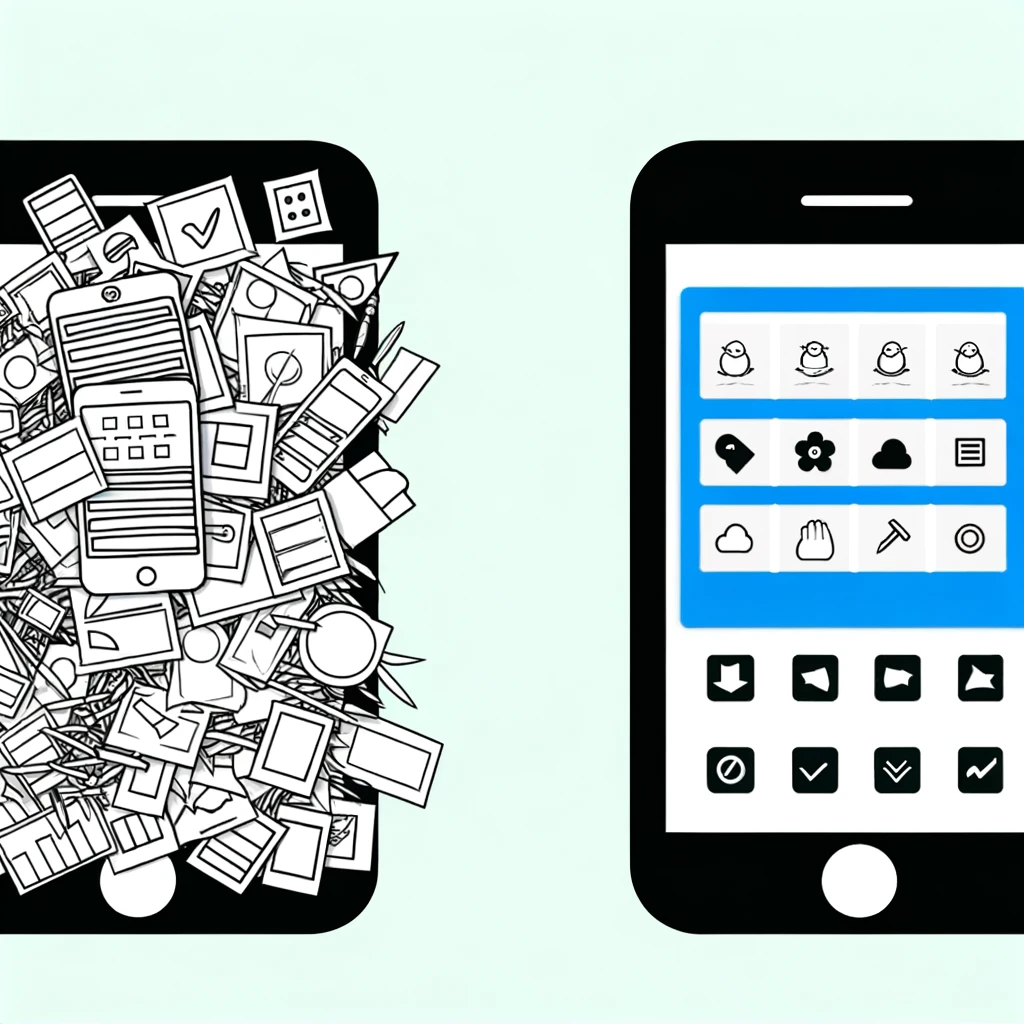In today's fast-paced digital landscape, it's easy to fall into the trap of feature overload. With the constant pressure to deliver more functionality, it's tempting to pack your digital product with as many features as possible. However, this approach can quickly lead to a host of problems that can ultimately ruin your product and alienate your users.

Understanding the Difference Between Features and Functions
Before we delve into the pitfalls of feature overload, it's important to understand the difference between features and functions. In product development, features refer to specific capabilities or attributes that a product offers. On the other hand, functions encompass the underlying processes and operations that enable these features to work.
Features can be thought of as the visible aspects of a product that users interact with. They are the tools and functionalities that make a product unique and valuable. For example, a messaging app may have features such as real-time messaging, group chats, and file sharing.
Functions, on the other hand, are the behind-the-scenes mechanisms that make these features possible. They are the algorithms, databases, and infrastructure that enable the product to perform its tasks. In the messaging app example, the functions would include message encryption, data storage, and server communication.
Features are what attract users to a product, while functions are what ensure that those features work seamlessly.
Defining Features and Functions in Product Development

In order to avoid feature overload, it's crucial to have a clear definition of the features and functions that your digital product offers. This involves thoroughly analyzing the requirements and objectives of your product, as well as considering the needs and expectations of your target audience.
Defining features and functions early on in the development process allows you to establish a strong foundation for your product. It helps you prioritize what is essential and aligns the development team's efforts toward a common goal.
When defining features, it's important to consider the value they bring to the user. Each feature should have a clear purpose and address a specific user need. This ensures that the product remains focused and avoids unnecessary complexity.
Similarly, defining functions involves determining the technical requirements and infrastructure needed to support the features. This includes considering factors such as scalability, security, and performance. By understanding the functions required, you can make informed decisions about the technology stack and architecture of your product.
The Pitfalls of Feature Addiction
One of the primary pitfalls of feature overload is falling into the trap of feature addiction. This occurs when you become so fixated on adding more features to your product that you lose sight of the underlying value and user experience.
Feature addiction often stems from a fear of missing out on the latest trends or competitive pressure to keep up with industry standards. However, it's important to remember that quality should always take precedence over quantity.
When you obsess over adding more features, you run the risk of overwhelming your users and diluting the core functionality of your product. Users may struggle to navigate through a cluttered interface or become confused by the abundance of options.
Moreover, adding unnecessary features can lead to increased development time and costs. It can divert resources away from refining existing features or addressing critical issues. This can ultimately hinder the overall user experience and impact the success of your product.
Instead of succumbing to feature addiction, it's important to focus on delivering a streamlined and intuitive user experience. Prioritize features that align with your product's core value proposition and enhance the user's ability to achieve their goals. By doing so, you can create a product that stands out for its simplicity, usability, and effectiveness.
Balancing Features and Requirements: Knowing When to Say No
While it's important to provide a comprehensive set of features, knowing when to say no is equally critical. This involves striking a delicate balance between fulfilling requirements and avoiding feature overload.
When faced with requests for new features, it's important to prioritize requirements that align with the core purpose of your product. By focusing on the essential functionalities, you can ensure that users have a streamlined and effective experience.
Prioritizing Requirements Over Feature Addiction
In order to avoid feature overload, it's crucial to prioritize requirements that align with the goals of your product. This means carefully evaluating each proposed feature and weighing its potential value against the potential drawbacks it may bring.
By prioritizing requirements over feature addiction, you can maintain a clear focus on the essential functionalities that truly enhance the user experience. This approach will enable you to deliver a more refined and polished product.
One aspect to consider when prioritizing requirements is the target audience of your product. Understanding your users' needs and preferences can help you determine which features are essential and which ones can be left out. For example, if your product is targeted towards professionals in a specific industry, it may be more important to focus on features that cater to their specific needs rather than adding generic features that may not be relevant.
Another factor to consider is the scalability of your product. As your user base grows, you may need to prioritize features that can accommodate a larger number of users. This could involve optimizing performance, improving security measures, or implementing features that enhance collaboration and communication among users.
Additionally, it's important to consider the resources available to you. Developing and maintaining features can require significant time and effort. By carefully evaluating the feasibility of each proposed feature, you can ensure that you have the necessary resources to implement and support them effectively. This will help prevent feature overload and ensure that the features you do include are well-executed and reliable.
Furthermore, it's essential to gather feedback from your users and stakeholders throughout the development process. This can help you identify which features are most important to them and make informed decisions about prioritization. By involving your users in the decision-making process, you can ensure that the features you choose to include are truly valuable and align with their needs and expectations.
Going Beyond Surface-Level Thinking: The Limitations of "Features"

In the realm of digital product development, it's essential to think beyond surface-level features. While features may grab attention and entice users initially, they are not the sole factors that determine long-term success.
When it comes to creating a successful digital product, it's important to consider the depth and robustness of your offering. Instead of solely focusing on features, you must also take into account the underlying infrastructure, usability, and scalability. These factors play a crucial role in ensuring that your product can withstand the test of time and provide lasting value to your users.
Imagine a scenario where a digital product boasts an impressive array of features, each designed to captivate users. At first glance, it may seem like a winning formula. However, upon closer inspection, you may discover that the product lacks the necessary foundation to support these features. The underlying infrastructure may be weak, leading to performance issues and user frustration. The usability may be compromised, making it difficult for users to navigate and fully utilize the features. And the scalability may be limited, preventing the product from adapting and growing alongside the users' needs.
The Importance of Depth in Product Development
A shallow product that emphasizes surface-level features may attract users initially, but it is likely to fall short in the long run. Users are becoming increasingly discerning, seeking products that not only offer a wide range of features but also deliver a seamless and satisfying experience. By investing time and effort into developing a comprehensive and well-rounded product, you can provide that lasting value.
Consider a digital product that takes a holistic approach to development. It goes beyond simply adding features for the sake of attracting users. Instead, it focuses on building a solid foundation that supports the features and enhances the overall user experience. The underlying infrastructure is robust and scalable, ensuring that the product can handle increasing demands and evolving technologies. The usability is carefully crafted, making it intuitive and easy for users to navigate and utilize the features effectively.
Furthermore, a product with depth considers the long-term sustainability of its features. It anticipates future needs and trends, allowing for seamless updates and enhancements. This forward-thinking approach ensures that the product remains relevant and valuable to users, even as their requirements evolve.
Moving Towards a More Holistic Approach to Product Design
To avoid the pitfalls of feature overload, it's crucial to shift towards a more holistic approach to product design. This involves looking beyond individual features and considering the overall user experience as well as the long-term sustainability and scalability of your product.
When designing a digital product, it's important to step back and consider the broader picture. How do the features fit into the overall user journey? How do they contribute to the product's value proposition? By taking a more holistic view, you can make more informed decisions about which features to prioritize and how to best optimize the user experience.
Additionally, a holistic approach involves understanding the interplay between different features. Rather than treating each feature as a standalone element, consider how they can work together to create a cohesive and seamless experience. This integration can elevate the overall value of your product and differentiate it from competitors.
Where to go from here?
It's important to remember that feature overload can be detrimental to your digital product. By understanding the difference between features and functions, prioritizing requirements, and taking a holistic approach to product design, you can avoid the pitfalls of feature overload and deliver a successful digital product that truly resonates with your users. So, next time you embark on a digital product development journey, remember to think beyond surface-level features and focus on creating depth, robustness, and a holistic user experience.
At Wednesday, we understand the intricacies of digital product development and the importance of avoiding feature overload. If you’d like to explore our services or talk to an expert for a free consult book a call here.
Enjoyed the article? Join the ranks of elite C Execs who are already benefiting from LeadReads. Joins here.






